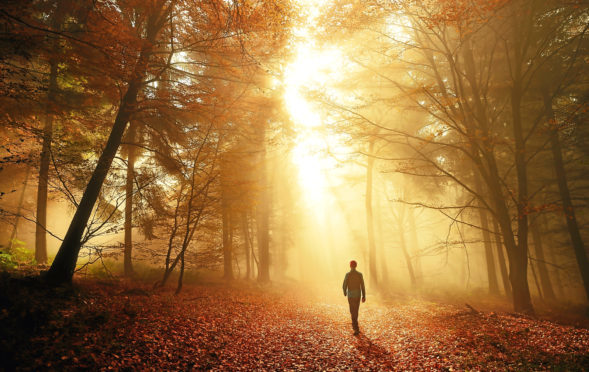I was reading in a Sunday newspaper (so it must be true) that doctors have started to prescribe a wonder cure to help with physical, emotional and mental wellbeing: go for a walk in the woods.
So far, so very straightforward. It’s practically my job description, and I feel physically, emotionally and mentally fine, thanks.
Ah, but (sayeth the Sunday newspaper) it has a name – forest bathing, and (wouldn’t you know it) a Japanese name – Shinrin-yoku, Japan being the new world epicentre in (wait for it) “green prescriptions”.
So now you can sign up for a forest therapy session and pay for expert guidance in the company of like-minded questers after green peace. Or you can you can just go for a walk in the woods. I’ve been doing it all my life, beginning with the Balgay Hill in childhood.
You find a place – a riverbank, the edge of a clearing, trees that frame a mountain, whatever – you make yourself comfortable with your back to a tree, and you wait for nature to turn up. At its best, it looks like this:
A roe deer walked out of the trees on the far side of the river. She grazed, she scratched her ears with a hind foot, tested the wind, drifted in and out of spotlights of sunshine. She was all curves and angles, poised, graceful, relaxed and alert all at the same time.
Then she turned her back on me and began to browse slowly, back the way she had come, into the trees and away from the river. So I watched the river for a while instead. It was high and hoarse and fast, fuelled by melting snow, and within a foot of the top of its natural banks.
Then a red squirrel came to drink. She was on the roe’s side of the river, head-first and halfway-down a pine trunk where she had paused, tail flattened against the bark and pointing straight up the tree.
She looked round. She watched the roe deer, which ignored her. She bounced down to the water’s edge then stopped dead. The water roared past a few inches below her feet. She leaned her nose towards it and pulled back, apparently fearful of the press of water.
She sat back, tail curved now. She looked around again. Was she weighing her options? Then she did this: she bounced back to the same tree she had climbed down and hit the trunk running. The deer turned to watch, then lost interest, stepped away, and missed the show.
The squirrel turned right at the first stout limb and ran along it. Then she jumped. She landed on a much more slender branch, still running. I realised then that this new branch belonged to a different tree. She reached its trunk, descended a few feet, and took to another branch.
This one was broken eight feet out from the trunk, broken but not snapped off, and beyond the break it angled down towards the water and rested, not in the river but on a rock with a steep, triangular face into which the river had worn out a little scoop. This scoop was now full of water.
The squirrel ran out to the break, jumped over it and ran down to the rock, spread herself wide and head-first across that triangular face and froze. Then she lapped all the water she needed from the scoop in the rock.
Then she retraced her steps, back over the rock, back up the branch to the break, over the break, along the branch to the trunk, up the trunk, along another branch, leaped over the oblivious roe deer’s turned back on to the original tree, reached its trunk ran up it, and vanished.
Questions:
Did she know about the broken branch, and the rock beneath with its small cache of water?
Had she used it before?
Was the whole thing a sophisticated, calculated manoeuvre?
Or was it all improvised, spontaneous, instinct rather than intellect?
Answer: I have no idea.
But I do know it’s the kind of thing that can happen when you go for a walk in the woods. I also know that such moments are good for you, that it feels as if nature has rewarded you for your patience by confiding in you one of her secrets.
I never once thought of such an encounter as a green prescription, although I think often that there is almost nothing that makes me feel better than when nature whispers in my ear and says: “Sit still, I’m going to show you something.”
It just never occurred to me before that there might be funding available as well.
* Jim Crumley will be at Pitlochry Festival Theatre’s Winter Words Festival on Sunday at 10am, talking about his latest book, The Nature of Winter, the second volume of his quartet about the seasons.
